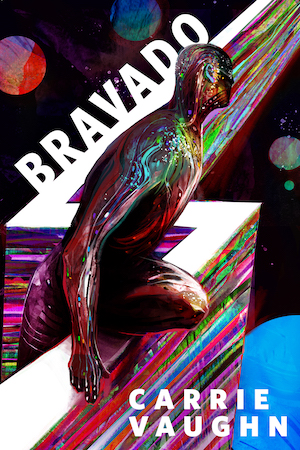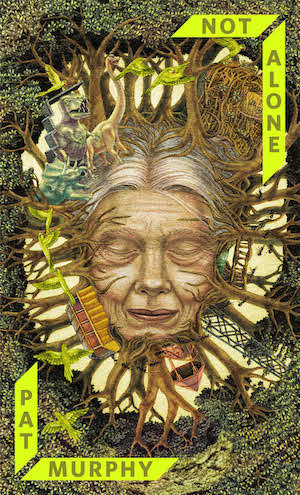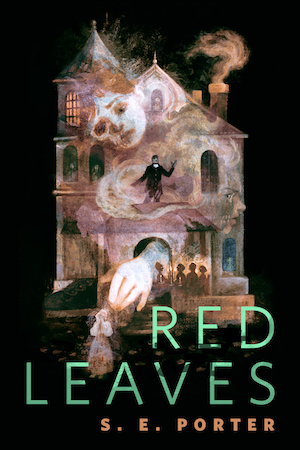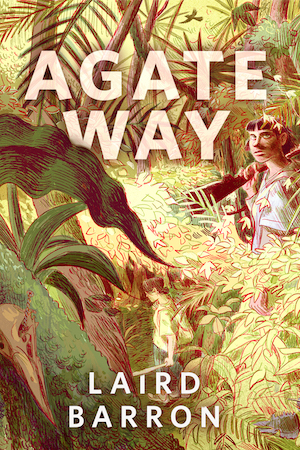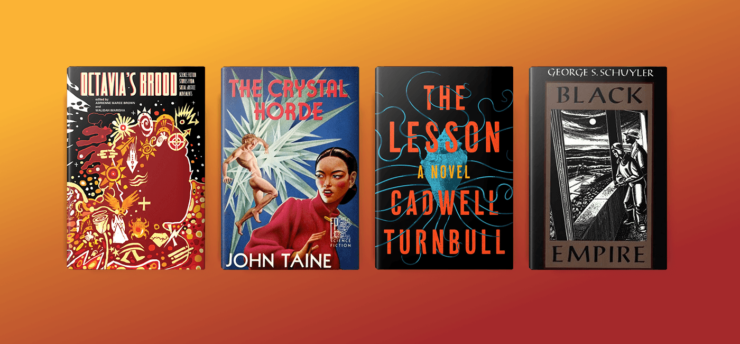Afrofuturism and solarpunk, powers combined. Everybody loves a team-up. Crossover events are a big deal…like Nutella mixed with good Trinidadian rum1. Two things that must go well together and, MY GOD, how could it be that this hasn’t been a staple of the food pyramid since 1972?
The intersection of Afrofuturism and solarpunk was the topic of a panel I suggested and moderated at Readercon 30 (you can watch the video of the panel here). My guests were Cadwell Turnbull, Michael J. DeLuca, and Readercon guest of honor Tananarive Due. The four of us and the audience (standing room only) took a tour of West Africa, the Caribbean, and the East Coast of the United States to explored story possibilities in each region that combined issues familiar to both subgenres.
It was dope. Fifty minutes of insightful, intelligent, (hopefully) inspiring conversation, and we barely scratched the surface. The inevitable consequence of a panel discussion like ours is that it leaves the audience thirsty for more. Unfortunately, there is currently a severe shortage of Afro-solarpunk stories being published. That shortage, in fact, was the impetus for the panel.
Tananarive Due teaches Afrofuturism at UCLA and she has seen little if any crossover between the two subgenres. Michael DeLuca publishes the journal Reckoning: Creative Writing on Environmental Justice. He is hunting for said crossover stories. While he has published Afrofuturist stories that address ecological concerns, they don’t really fit the solarpunk model (more on exactly what that is in part two of this essay).2
Cadwell’s novel, The Lesson, is closer to Afro-solarpunk than most, but the involvement of alien technology in creating ecofriendly habitats is an element that again strains solarpunk conventions.3
Milton Davis is a well-known author, anthologist of Black speculative fiction, and proponent of indie publishing. I asked him to point me towards more stories that fit the bill. Yet what he sent me was much more eco than solarpunk (there’s a difference) and clearly dystopian, the antithesis of solarpunk.
Afrofuturism and solarpunk have been around long enough to have met in a crowded SOHO bar and taken a selfie together. Yet here we are. What follows is an examination of the barriers between the two and how we might break them. But first, let’s get better acquainted with our subjects on their own terms. This essay, part one, will explore Afrofuturism: the name, the need, its position within or adjacent to science fiction, and some of its characteristics that I believe make for a fruitful pairing. The following essay, part two, will do the same with solarpunk, try to understand the barriers, and discuss possibilities for bringing these subgenres together.
What’s in a Name?
In general, I hesitate to too firmly attach a label to anything, and the stories that would be Afrofuturism are exceptionally mercurial. There have been many names: Afrofuturism, Black sci-fi, Écriture Noire, Afrodiasporic writing, Black anti-science fiction (Yaszek, 2006).
Alondra Nelson founded the Afrofuturism listserv in 1998, possibly the first digital network of creatives to collectively self-identify as Afrofuturist. There they discussed works that told stories about culture, technology, science fiction imagery, futurism, and innovation as it related to Black communities. It was a sounding board and crossroads where artists, writers, and musicians collectively built the aesthetic that they called Afrofuturism4, a term first coined by Mark Dery (Nelson, 2002).
As Tananarive Due told us during the panel, there are now artists and authors who much prefer the term “Black Speculative Arts Movement.” They have gained traction. Tananarive herself sees Afrofuturism and Black speculative arts as synonymous umbrella terms expansive enough to shelter stories of science fiction, fantasy, horror, and magical realism, amongst other subgenres.5
While it seems we are free to use either term at the same taxonomic level, for the purposes of our inquiry, I will temporarily reclassify Afrofuturism as a subgenre within Black speculative arts to narrow our focus. The combined root and suffix are semiotically more relevant to our search for congruence with solarpunk. Futurism implies a special relationship with technology and time. But here we must take more than a moment to distinguish the futurism of mainstream science fiction from that of Afrofuturism while at the same time preempting the inevitable question, “Why must color or race hyphenate science fiction at all?” It’s important to make this clear, because the answer has implications for the combination of Afrofuturism and solarpunk.
Necessary Pressure
“In order that we may survive…our kind of evolution is better than theirs…Nature blundered when she made those brutes. Take it from me, it is not mere chance that gave [our species] a long lead over their competitors…in the race toward evolution and a higher form of life. Whatever we may be we are less fiendish than they are.” Excerpt taken from White Lily (later retitled The Crystal Horde) by John Taine, 1930 (Santesso, 2014).
At a convention not-to-be-named, the moderator on a panel on utopianism remarked, “Science fiction has always been inclusive.” If you come across a similar statement on the interwebs and need quick and dirty ammo for your retort, you can thank author Nisi Shawl. She has gone ahead and done the homework for you by creating a timeline of prominent black science fiction stories. Nisi points out a decades-wide gap in the literary record from the late Twenties and into the mid-Forties. What you will find instead is the rise of pulp science fiction and fantasy.6
The Pulp Era was instrumental in establishing the imagery, tropes and themes at the core of modern science fiction, much of which was adapted from and inspired by the futurist literary and cinematic art movements from earlier in the century. Unfortunately, that heritage also transmitted stories normalizing primitivism, scientific racism, eugenics, anti-Semitism, and associated reinforcing fascist constructs (Santesso, 2014).
It is an open debate as to how much this toxic schema of the pulp era stories continues to influence modern sci-fi. The Futurians could only do so much. To the extent that this demon has been exorcised—if it has truly been exorcised at all—one could point to the rise of critical theory and the attending identity politics of the New Wave-focused sci-fi stories and genre analysis for its decline (Santesso, 2014).7
The artistic rendering of black bodies, voices, and experiences into places where we were/are ghettoed, excluded, and disappeared is essential to the movement of Afrofuturism and necessary pressure on science fiction. And yet Afrofuturism for the most part has matured outside of what cultural critic Kudwo Eshun calls the “futures industry,” the integrated worldview produced by late stage capitalism, global media, and major scientific research. This worldview projects a very specific future that has a strong symbiotic relationship with science fiction, and puts African diasporic communities at the periphery of modern experience while binding us in a narrative of fractal dystopias (Eshun, 2003).
Black artists, writers, literary scholars, and cultural anthropologist have canonized and refined their own critical pedagogy and tropes upon which Afrofuturism draws inspiration (Womack, 2013) (Nelson, 2002). But it is rare that these texts based on our subjective experience inform science fiction directly.8 We are estranged from the so-called genre of estrangement. This leads to, among other things, some very bad science fiction.
Robots were So Far Inferior, They had No Rights which Man was Bound to Respect
As previously stated, Black communities have a special relationship with technology in the Americas. Without putting too fine a point on it, for a time we were the technology, legally transformed from human to machine and then partially back again (Kakoudaki, 2014). Robot/slave narratives that do not take this into account are built on shaky ground from the start.
Let’s take the 2004 movie I, Robot starring Will Smith as case study.9 An Afrofuturist lens exposes a fistful of glaring problems. Will Smith’s character10 is black and a racist cop11 (Eshun, 2003) (Kakoudaki, 2014). The Chicago police are portrayed as an unquestionably non-antagonistic yet naïve institution with both advanced firepower and instant access to information.12 Near future Chicago is still somehow predominantly white. Rebelling robot slaves are the primary antagonistic force. Their rebellion is conflated with a contrived misinterpretation of The Three Laws of Robotics13 when an upgrade turns slaves into mindless, fascist shock troops bent on regime change. The good robots are preemptively destroyed by their more advanced counterparts, because they would obey their Three Laws programming and try to save their human masters.
And while the only thing the movie takes from Asimov is his Three Laws of Robotics (It’s closer to the story by Eando Binder14 than to Asimov’s collection by the same name), the Three Laws themselves present their own problems (Kakoudaki, 2014).
The very origins of American pre-Civil War history is built upon the translation of the Three Laws into legal code. The post-Civil War period was White America’s politically reactionary and physically violent response to the transgression of these laws. Ostensibly, Asimov’s well-written literary realist thought experiment had already been litigated to the highest court of the land.
The reviews for I, Robot were mixed. Todd McCarthy from Variety put it best: “A failure of imagination.” This story was tired well before 2004.15 Furthermore, it illustrates the pitfalls of putting blackface on science fiction. An integrated Sci-fi/Afrofuturism canon16 would have provided more intimate and powerful tools to tell stories that question our shared futures and the dynamics of race and class.
The ability and willingness to draw upon non-traditional sources beyond standard science fiction becomes another bridge by which we connect to solarpunk.17
“The Black Writer Lies in the Guts of Old America, Making Readings about its Future.” (Ishmael Reed)
Reframing the future (we will be there), the present (we already here), and the past (we been here since before the Mayflower) is a necessary act of rebellion and historic revisionism that can leg sweep discursive formations supporting the whitewashed mythology of world history and make room for transformation (Nelson, 2002).
Afrofuturism is a means to connect with a living, usable past in contrast to Futurist attempts at a swift and violent break: “The distillation of African diasporic experience, rooted in the past but not weighed down by it, contiguous yet continually transformed” (Nelson, 2002).
Recreating, and rediscovering systems of knowledge are a healing act of discovery.18 Symbols originated from those hidden histories, indigenous experience, and aboriginal memory19 expand the repertoire of fantastical elements. This is one way that stories based on Afrofuturist concepts illustrate visions of social justice (Womack, 2013).
Social justice activism has always been in constant dialogue with Afrofuturism. W.E.B. Du Bois’s “The Comet” imagines the positive impact a natural disaster might have on race relations. George S. Schuyler’s Black Empire has striking similarities to Killmonger’s plan for world domination in Black Panther. Tananarive is the daughter of activist Patricia Stephens Due and civil rights lawyer John D. Due Junior. She is not surprised by how many of her students are also activists.
Though she did not self-identify as an Afrofuturist, many of Octavia E. Butler’s stories fit into the subgenre, and they inspired Octavia’s Brood, a short story anthology that brought togetheractivists and science fiction writers. And here’s one for you; Black Lives Matter even has an Afrofuturist celebration: “Black Futures Matter.”
Afrofuturism is partially energized by the shared trauma of people systematically severed from their roots and the perception by many that the Civil Rights movements of the mid-twentieth century had failed. It is the perennial plot problem, Promised Land, and Utopian vanishing point all rolled into one. And yet, I must agree with Tananarive’s more hopeful take: Success was never guaranteed within one lifetime but is the work of many.
The arc of history does not naturally bend towards justice. Neither does the trajectory of science fiction. Both must be bent. Producing and disseminating Afrofuturist stories and integrating them with sci-fi are integral to that great feat of emotional labor. However, there is no just future built atop (or buried under) the dystopian wreckage of an environment in freefall. Make way for Afro-solarpunk.
Bibliography
Eshun, K. (2003). Further Considerations on Afrofuturism. The New Centennial Review Volume 3, Number 2, Summer, 287-302.
Kakoudaki, D. (2014). Anatomy of a Robot: Literature, Cinema, and the Culture Work of Artificial People. New Rrunswick, New Jersey: Rutgers University Press.
Nelson, A. (2002). Introductions. Social Text 20.2 Summer, 1-14.
Santesso, A. (2014). Fascism and Science Fiction. Science Fiction Studies, 136-162.
Womack, Y. L. (2013). Afrofuturism: The World of Black Sci-Fi and Fantasy Culture. Chicago: Lawrence Hill Books.
Yaszek, L. (2006). Afrofuturism, Science Fiction, and the History of the Future. Socialism and Democracy Volume 20, 41-60.
Rob Cameron (though not his real name, it is written on all of his bylines) writes strange stories, one of which, “Squeeze” can be found in Mike Allen’s anthology Clockwork Phoenix 5 (Mythic Delirium, 2016). His story “Tatterdemallion at the End of the Universe” is curriculum material for the Carterhaugh School of Folklore and the Fantastic. He is a linguist and an ENL teacher in Brooklyn. When not getting paid, he is managing editor and a producer for the Kaleidocast.nyc, a lead organizer for the Brooklyn Speculative Fiction Writers, sometimes curator for the New York Review of Science Fiction’s Reading Series, the Surreal Symphony of Zak Zyz, and also does speculative fiction programming at the Center for Fiction and BSFW’s Expert Series. He is also a pie addict with neither regrets nor inclinations towards rehab.
[1]Half-cup evaporated milk, half cup Nutella. Heat and whisk. Add rum (as noted, the good stuff). You’re welcome, America.
[2]Michael has published Sofia Samatar’s “Request for an Extension on the Clarity” (in LCRW 33), Brandon O'Brien’s “Papa Bois and the Boy”, Innocent Ilo’s “To the Place of Skulls”, Osahon Ize-Iyamu’s “More Sea Than Tar”, and Stylo Starr’s “Fight or Flight”.
[3]But honestly, who cares? Read the book. It’s excellent.
[4]While the focus here is on narrative patterns, I would be remis not to mention Sun Ra’s huge influence on Afrofuturism everything.
[5]I should say here that of course there are sub or parallel genres such as Afro-surrealism and African futurism. My essay is in no way meant to be definitive in its categorization, but a heuristic to build pathways of collaboration.
[6]Nisi does soften the blow with author and librarian Jess Nevin’s caveat that the race of many anonymous authors published during this time are, as of yet, unknown. I also found George Schuyler’s Black Empire (1936-1938) and Leslie F. Stone’s “The Fall of Mercury” (1935). Also, many black authors are known to self-publish their stories door to door, out the back of their car, etc. Still, that they are so difficult to find in the Pulp to Golden Age era is the point. The publication of fascism-infused science fiction stories really hit the gas in terms of sheer numbers during this period.
[7]For further reading, I highly recommend Ann and Jeff VanderMeer’s “The Big Book of Science Fiction.” The essay on sci-fi history alone is worth its weight in gold.
[8]“Learning from Other Worlds” by Patrick Parrinder is “a definitive look at the state of science fiction studies today.” Published in 2001, there is not a single mention of Afrofuturism in the essays which reference nearly a century’s worth of critical analysis.
[9]This example is taken from visual media instead of the written word, but we can no longer talk about one without referencing the other, especially in regards to the social critique and impact on popular culture.
[10]This marks the first of two occasions Will Smith has played a racist cop. Please, don’t go for the hat trick, Mr. Blockbuster.
[11]That his racism is directed at robots goes directly to the influence of the futures industry and the metaphor of black bodies as machines, regardless of their approximation of humanness and the uncanny valley.
[12]This ignores the history of police in the United States, from the present reality back to its inception (which in some cases were specifically designed to suppress the black populations: https://psmag.com/social-justice/why-black-america-fears-the-police). Though this should not be a surprise, as there is are strong noir elements to the story—a genre that has been found to be inherently conservative (Santesso, 2014).
[13]The final boss A.I. is gendered female, VIKI. Analysis of this choice on the part of the filmmakers is beyond the scope of this essay, but…it’s certainly an interesting choice.
[14]In the original story, the creator of the robots, Dr. Link, desires to create emancipated robots in the hope of staving off an inevitable robot rebellion, which is closer to the actual story arc of the movie.
[15]“I Robot” was directed by Alexander Proyas, the same director of the smash blunder that was “Gods of Egypt.” Proyas gets points for bringing us the “The Crow,” but his blind spots are telling.
[16]Nalo Hopkinson’s “Ball Lightning” or Octavia Butler’s “Blood Child” (Yaszek, 2006) to name just a couple. Hopkinson’s story even has robots!
[17]Take for example Alondra Nelson’s critique of Allucquere Rosanne “Sandy” Stone’s treatment of the self-concept in the “virtual age.” Allucquere was not aware of the trove of experience and scholarly work centered around Du Bois’ double conscious and the realities of fractured consciousness under oppression.
[18]Ishmael Reed’s Mumbo Jumbo is an excellent place to start.
[19]See Ytasha L. Womack’s discussion of the Dagara with Dr. Malidoma in her book “Afrofuturism” and Yvonne Chireau’s “Black Magic” for history of the American Hoodoo. Also, Pablo Gomez’s “The Experiential Caribbean: Created Knowledge and Healing in the Early Modern Atlantic” (UNC Press, 2017)


